Why Fresh Basil Pesto Sauce Changes Everything
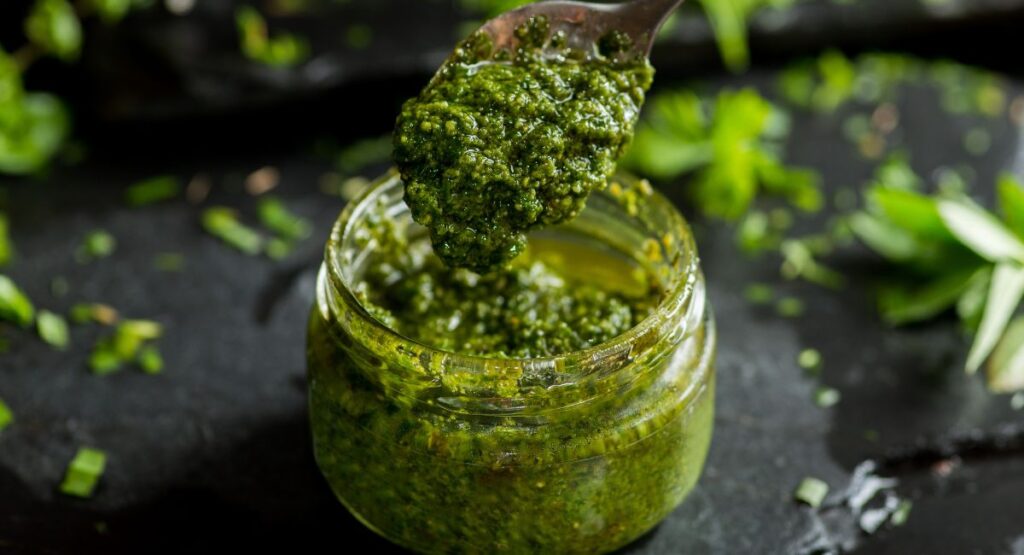
I still remember the first time I made fresh basil pesto sauce at home. I didn’t have high expectations that it would become my regular sauce/dip with many dishes.
One summer afternoon, I brought home a bunch of basil, and its fragrance filled the kitchen.
I tossed it in a blender along with a handful of pine nuts, a little Parmesan cheese, and some good olive oil. As the blades whirred, the kitchen was filled with the aroma of Italy.
I drizzle it over warm pasta, squeeze a little lemon juice, and that’s it—I’m hooked.
Homemade basil pesto sauce is more than just a recipe. It’s the easiest way to transform simple foods into something extraordinary.
This basil pesto sauce is just that simple. Best of all: it only takes 10 minutes. No cooking, no complicated steps, just a few high-quality ingredients combined.
What You’ll Need ( ingredients for basil pesto sauce)
Good pesto sauce starts with simple, fresh ingredients.
Each one brings something special — flavor, texture, or that creamy finish everyone loves.
Here’s what you’ll need and why it matters:
1- Fresh Basil Leaves
Basil is the heart of any true pesto sauce.
Go for bright green leaves that smell sweet and peppery — skip any that look bruised or dark.
Give them a quick rinse, then pat dry gently with a towel.
Too much water will dull that gorgeous color and make the sauce watery.
2- Pine Nuts (or a Nut Swap You Love)
Pine nuts add that buttery, slightly sweet flavor that balances the basil perfectly.
If you can’t find them or they’re too pricey, don’t stress.
Try walnuts for a hearty flavor, pistachios for a touch of sweetness, or almonds for a mild, smooth texture.
Whatever you pick, toast them for a minute or two — that’s what gives pesto its deep, nutty aroma.
3- Parmesan Cheese (or Another Hard Italian Cheese)
Freshly grated Parmesan makes the pesto creamy and salty in all the right ways.
If you’re out of Parmesan, use Pecorino Romano for a sharper bite, Asiago for a mellow nuttiness, or Grana Padano for a slightly sweeter taste.
They all melt beautifully into the sauce and help bind everything together.
4- Garlic
A little garlic goes a long way here.
It brings that bold kick that makes pesto come alive.
For a gentler flavor, use roasted garlic instead of raw — it’s soft, buttery, and doesn’t overpower the basil.
If you’ve never roasted garlic before, here’s a great guide from Simply Recipes.
5- Extra Virgin Olive Oil
Your olive oil is what ties everything together.
It gives pesto that silky, luscious texture and rounds out the flavors.
Use a good-quality extra virgin olive oil — something fruity but not too bitter.
Pour it in slowly while blending so the sauce emulsifies and stays glossy.
6- Fresh Lemon Juice
Just a teaspoon of lemon juice makes a huge difference.
It brightens the sauce, keeps it that vivid green color, and lifts every flavor in the mix.
Some traditional recipes skip it, but trust me — once you add it, you’ll never go back.
7- Salt & Black Pepper
A pinch of both makes everything pop.
Start light, then taste and adjust at the end.
Remember, your cheese already adds saltiness — so season carefully.
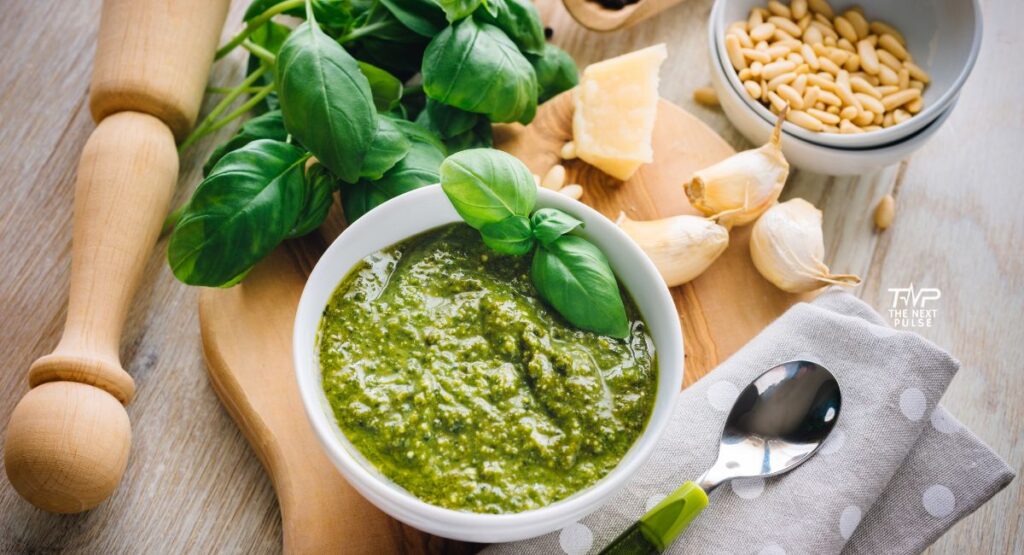
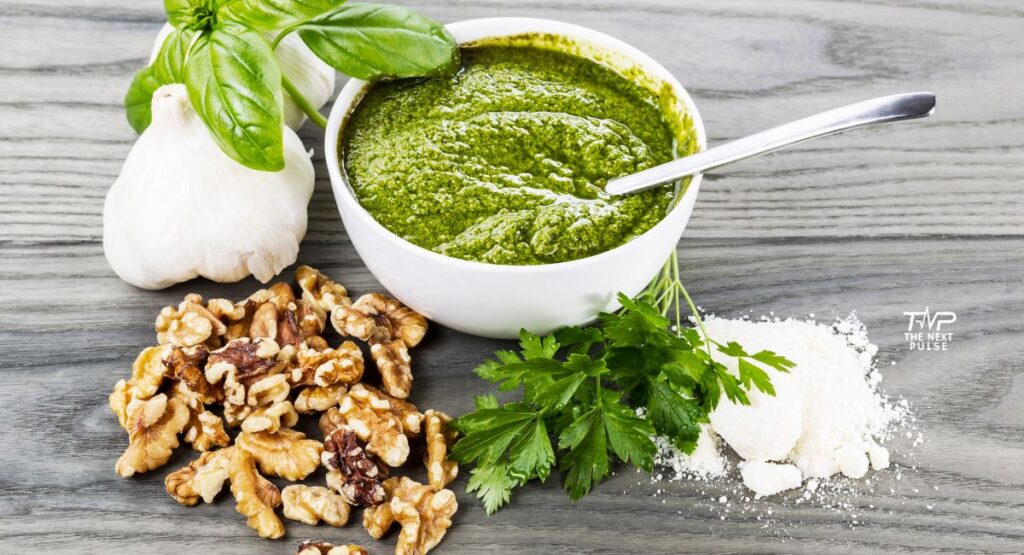
Food Processor or Mortar and Pestle?
Here’s the thing — both work.
I use a food processor when I’m in a rush. But if you want that old-school texture, grab a mortar and pestle. The flavor is slightly different — more rustic, less blended, more “alive.”
Traditional pesto from Liguria, Italy, is made that way. If you want to read more about that tradition, check out The Mediterranean Dish — she does a beautiful job explaining it.
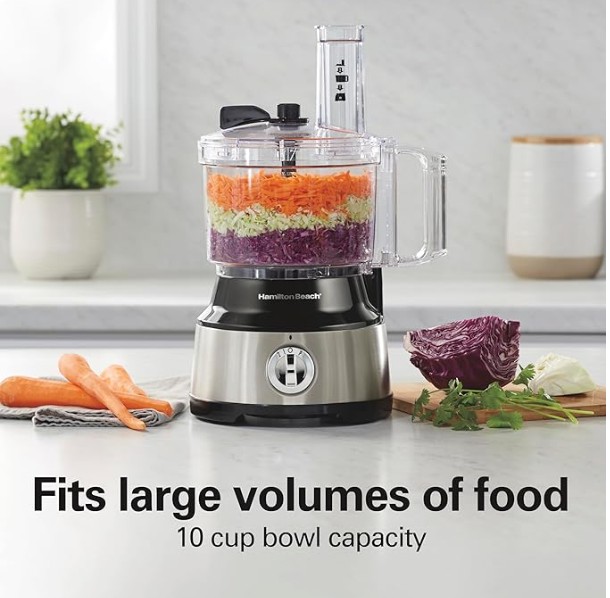
Hamilton Beach Food Processor
You can slice, shred, chop, mix and puree a wide variety of ingredients — the stainless steel slicing/shredding disc and chopping blade make it easy.
Built-In Bowl Scraper Saves Time, Slice, Shred, Chop, Mix and Puree with 2 Versatile Attachments
This post may contain affiliate links from Amazon
How to Make Homemade Pesto Sauce (in Just 10 Minutes)
- Toast the nuts.
Place your pine nuts (or whatever nuts you’re using) in a small dry skillet over medium heat.
Shake the pan gently for 2–3 minutes, just until they turn golden and smell toasty.
Once toasted, set them aside to cool.
🔸 Chef Tip: Toasting deepens the flavor and adds that warm, nutty aroma that makes good pesto unforgettable.
- Prep the Basil.
Pick off any dark or wilted basil leaves.
Rinse them under cold water, then pat completely dry with a paper towel.
Wet leaves can dilute your pesto and make it appear dull in color.
🔸If you want to keep it extra green, toss the leaves in a bowl of ice water for a minute, then dry — this little trick locks in that vibrant color.
- Start the Base
In your food processor, add: Basil leaves, toasted nuts, garlic, and parmesan cheese. Pulse it a few times until everything is finely chopped but not pureed. You’re just creating a base here — not a paste.
🔸 Texture check: You should still see tiny flecks of basil and nuts — think “rustic,” not “baby food.”
- Add the Olive Oil
With the processor running on low, slowly drizzle in olive oil through the top.
This gradual pour helps the sauce emulsify — creamy, not oily.
Once it looks smooth and slightly thick, stop blending.
🔸 Chef Tip: If your pesto looks too thick, add a tablespoon of cold water or a touch more oil to loosen it up.
- Add Lemon Juice, Salt & Pepper
Now’s your chance to balance the flavors.
Add lemon juice to brighten it, salt to enhance it, and a pinch of black pepper.
Pulse a few more times to mix everything.
🔸 Taste it straight from the spoon.
If it feels flat, add a squeeze more lemon.
If it’s too sharp, a spoon of cheese will mellow it out.
- Final Taste test and texture
Add more cheese for richness or lemon juice for brightness. Your pesto should be creamy but not runny — it should cling to a spoon. If you dip a piece of bread in and it coats evenly, you nailed it.
That’s it. You just made homemade basil pesto.
Chef’s Pro Tips for Perfect Pesto Sauce
- Always use cold basil — it helps keep the green color vibrant.
- Don’t overblend — the heat from blades can dull the flavor.
- Toast the nuts; raw ones make the sauce flat.
- Go easy on salt — Parmesan adds plenty.
- Want it extra smooth? Add a teaspoon of water while blending.
Easy Variations You’ll Love
- Vegan pesto: skip the cheese, add 2 tablespoons of nutritional yeast.
- Spinach or kale pesto: half basil, half greens for a milder taste.
- Walnut pesto: slightly sweeter and creamier.
- Sun-dried tomato pesto (Pesto Rosso): swap basil for tomatoes and almonds.
How to Store and Freeze Pesto Sauce the Right Way
I like to spoon it into an ice cube tray, freeze it, and store the cubes in an airtight bag. That way, you can drop a cube into hot pasta/noodles or soup anytime — instant homemade flavor.
Try it with Creamy Pesto Chicken Pasta or melt it over roasted potatoes for a quick dinner upgrade. And when summer’s long gone, those little cubes bring back that garden-fresh basil taste like magic. More storage tips? Love and Lemons shares a great freezer-friendly trick using small jars. Pesto keeps beautifully, so make a big batch while basil’s in season.
How to Serve Basil Pesto Sauce (Beyond Pasta!)
This sauce isn’t just for spaghetti.
Here’s how I actually use it at home:
- Toss it with warm pasta/Noodles, a splash of pasta water, and extra cheese.
- Spread it on sandwiches or wraps instead of mayo.
- Mix a spoonful into soups or stews for instant freshness.
- Drizzle it over roasted veggies — carrots, potatoes, cauliflower, anything!
- Stir it into scrambled eggs or omelets for a bright green kick.
- Use it as a pizza base under melted mozzarella.
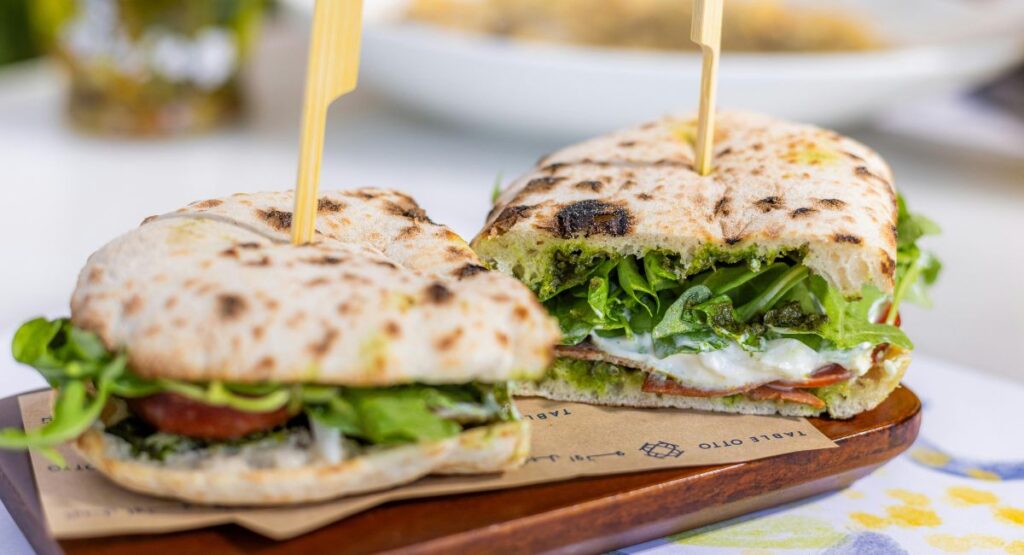
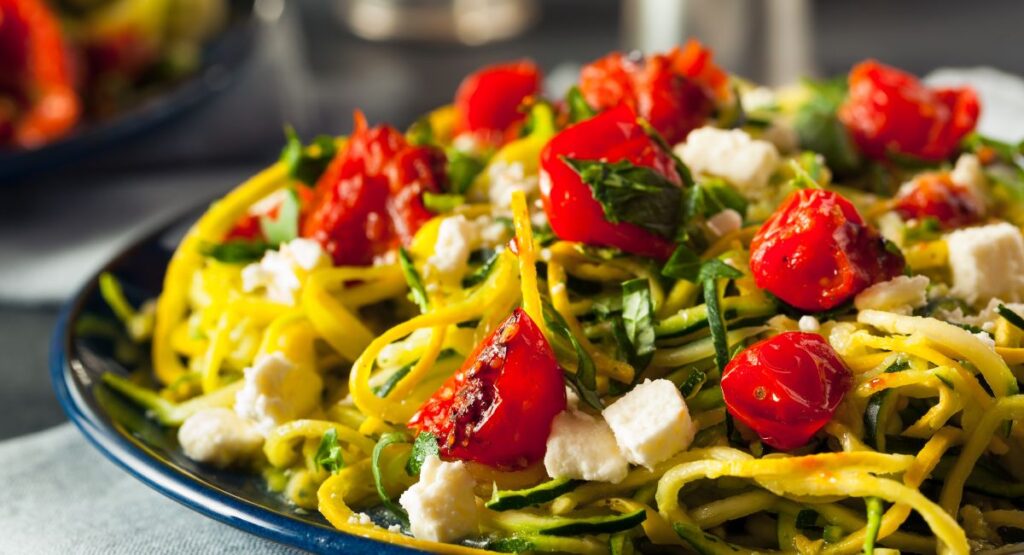
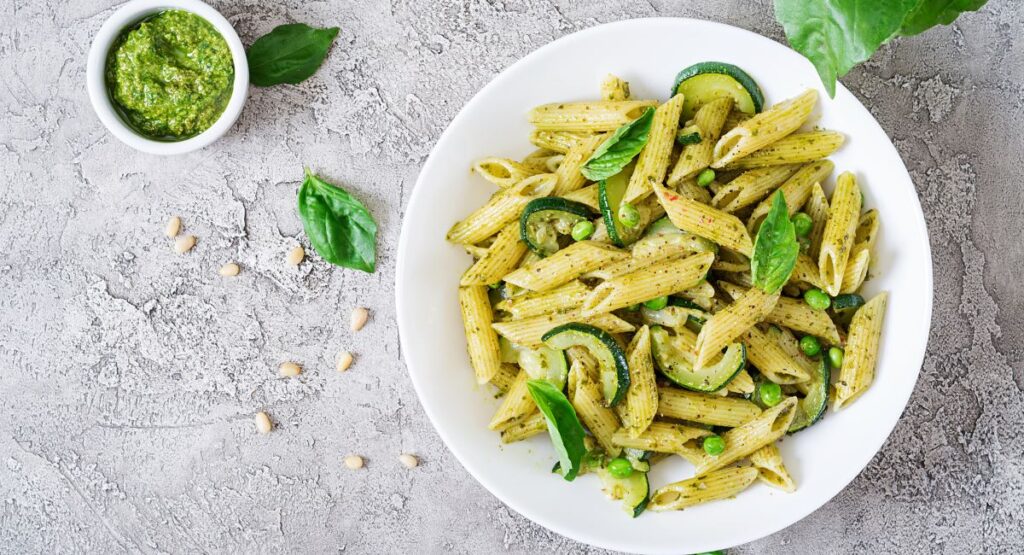
This pesto sauce isn’t just for pasta — it’s your new kitchen all-rounder. Spread it on toasted bread for a quick pesto sandwich, swirl it into soup for a flavor boost, or drizzle it over roasted veggies.
When I’m craving something light, I toss a spoonful into my Low-Carb Pesto Zucchini Noodles — it’s fresh, fast, and so satisfying. You can even mix it into salad dressings or spoon it over grilled chicken. Once you start, you’ll find yourself reaching for that pesto sauce jar almost daily.
Nutritional Facts (Per 2 Tablespoons Serving)
- Calories: 200
- Total Fat: 20g
- Saturated Fat: 3g
A quick note from the kitchen:
Pesto is naturally high in healthy fats from olive oil and nuts, which makes it a great heart-healthy addition to meals. Use it as a flavor booster rather than a sauce you drown your pasta in — a little goes a long way.
If you’re following a low-carb, keto, or Mediterranean-style diet, this recipe fits right in perfectly.
Common Pesto Mistakes (I’ve Made Them All)
- Using old basil — it turns bitter and dull.
- Adding too much garlic — it kills the balance.
- Skipping the nut toasting step — flavor goes flat.
- Overblending — you lose that fresh, green punch.
FAQ
Yes. Try nutritional yeast or just skip it — still delicious.
Nope. It changes the flavor completely. Fresh basil is key.
Up to one week in the fridge, or 3 months frozen.
Yes — try sunflower seeds for a nut-free version.
Too much blending or exposure to air. Add lemon juice and keep it covered.
Pesto is actually very healthy when enjoyed in moderation. It’s full of heart-healthy fats from olive oil and nuts, plus vitamins from basil and garlic.
Pesto tastes fresh, herby, nutty, and slightly garlicky.
You can enjoy pesto in so many ways — tossed with pasta, spread on sandwiches, stirred into soups, or drizzled over grilled veggies or chicken.
It’s also amazing in Pesto Zucchini Noodles with Cherry Tomatoes for a lighter twist.
Pesto is usually served at room temperature or slightly warm, not hot. High heat can dull the basil’s fresh flavor and turn the sauce bitter. So, if you’re mixing it with pasta, add the pesto after the pasta is cooked — when it’s warm, not piping hot.
Quick Recap
So there you go — real, homemade basil pesto.
Fresh basil. Good oil. A quick blend.
No preservatives, no weird aftertaste. Just honest, Italian-inspired flavor.
Try making it once, and you’ll never go back to the jar.
If you do make it, tag your version — I’d love to see your twist!
And remember, good pesto isn’t about perfection. It’s about freshness, balance, and the joy of making something with your hands.
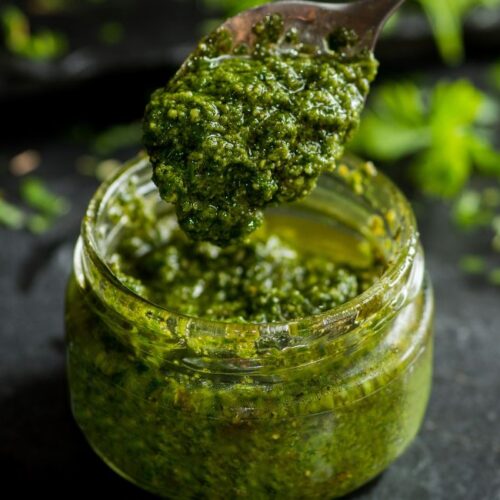
Homemade Basil Pesto Sauce in 10 Min
Equipment
- Food Processor
- Mortar and Pestle.
Ingredients
Fresh basil leaves: use bright green ones, no dark spots.
Pine nuts: classic choice. Toast them lightly to wake up their flavor.
Garlic: one clove if you like it mild, two if you love bold.
Parmesan or Pecorino cheese: gives that salty, nutty depth.
Extra virgin olive oil: pick a fruity one for smooth texture.
Lemon juice: adds a fresh, zesty lift and keeps your pesto green.
Salt + black pepper: to balance everything.
Instructions
Toast the nuts.
Just 2–3 minutes on a dry pan until they smell amazing.
Don’t walk away — they burn fast.
Add basil, garlic, nuts, and cheese to your processor.
Pulse a few times until everything’s finely chopped.
Stream in olive oil slowly.
Keep pulsing until it looks creamy but still has texture.
Add lemon juice, salt, and pepper.
Blend one more time to bring it all together.
Taste test.
Add more cheese for richness or lemon juice for brightness.
Notes
And remember, good pesto isn’t about perfection. It’s about freshness, balance, and the joy of making something with your hands. Tag us on Instagram @thenextpulse25 and Pinterest @thenextpulse
